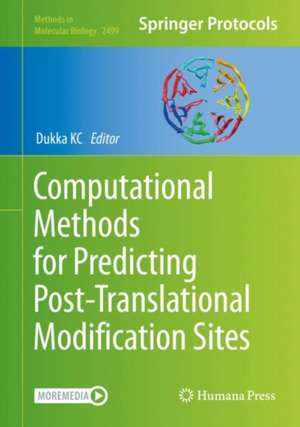Computational Methods for Predicting Post-Translational Modification Sites: Methods in Molecular Biology, cartea 2499
Editat de Dukka B. KCen Limba Engleză Paperback – 14 iun 2023
Authoritative and cutting-edge, Authoritative and cutting-edge, Computational Methods for Predicting Post-Translational Modification Sites aims to be a useful guide for researchers who are interested in the field of PTM site prediction.
| Toate formatele și edițiile | Preț | Express |
|---|---|---|
| Paperback (1) | 950.84 lei 6-8 săpt. | |
| Springer Us – 14 iun 2023 | 950.84 lei 6-8 săpt. | |
| Hardback (1) | 1394.03 lei 6-8 săpt. | |
| Springer Us – 14 iun 2022 | 1394.03 lei 6-8 săpt. |
Din seria Methods in Molecular Biology
- 9%
 Preț: 791.63 lei
Preț: 791.63 lei - 23%
 Preț: 598.58 lei
Preț: 598.58 lei - 20%
 Preț: 882.98 lei
Preț: 882.98 lei -
 Preț: 252.05 lei
Preț: 252.05 lei - 5%
 Preț: 802.70 lei
Preț: 802.70 lei - 5%
 Preț: 729.61 lei
Preț: 729.61 lei - 5%
 Preț: 731.43 lei
Preț: 731.43 lei - 5%
 Preț: 741.30 lei
Preț: 741.30 lei - 5%
 Preț: 747.16 lei
Preț: 747.16 lei - 15%
 Preț: 663.45 lei
Preț: 663.45 lei - 18%
 Preț: 1025.34 lei
Preț: 1025.34 lei - 5%
 Preț: 734.57 lei
Preț: 734.57 lei - 18%
 Preț: 914.20 lei
Preț: 914.20 lei - 15%
 Preț: 664.61 lei
Preț: 664.61 lei - 15%
 Preț: 654.12 lei
Preț: 654.12 lei - 18%
 Preț: 1414.74 lei
Preț: 1414.74 lei - 5%
 Preț: 742.60 lei
Preț: 742.60 lei - 20%
 Preț: 821.65 lei
Preț: 821.65 lei - 18%
 Preț: 972.30 lei
Preț: 972.30 lei - 15%
 Preț: 660.49 lei
Preț: 660.49 lei - 5%
 Preț: 738.41 lei
Preț: 738.41 lei - 18%
 Preț: 984.92 lei
Preț: 984.92 lei - 5%
 Preț: 733.29 lei
Preț: 733.29 lei -
 Preț: 392.60 lei
Preț: 392.60 lei - 5%
 Preț: 746.26 lei
Preț: 746.26 lei - 18%
 Preț: 962.66 lei
Preț: 962.66 lei - 23%
 Preț: 860.22 lei
Preț: 860.22 lei - 15%
 Preț: 652.64 lei
Preț: 652.64 lei - 5%
 Preț: 1055.50 lei
Preț: 1055.50 lei - 23%
 Preț: 883.87 lei
Preț: 883.87 lei - 5%
 Preț: 1141.13 lei
Preț: 1141.13 lei - 19%
 Preț: 491.89 lei
Preț: 491.89 lei - 5%
 Preț: 1038.86 lei
Preț: 1038.86 lei - 5%
 Preț: 524.16 lei
Preț: 524.16 lei - 18%
 Preț: 2122.34 lei
Preț: 2122.34 lei - 5%
 Preț: 1299.23 lei
Preț: 1299.23 lei - 5%
 Preț: 1339.12 lei
Preț: 1339.12 lei - 18%
 Preț: 1390.26 lei
Preț: 1390.26 lei - 18%
 Preț: 1395.63 lei
Preț: 1395.63 lei - 18%
 Preț: 1129.65 lei
Preț: 1129.65 lei - 18%
 Preț: 1408.26 lei
Preț: 1408.26 lei - 18%
 Preț: 1124.92 lei
Preț: 1124.92 lei - 18%
 Preț: 966.27 lei
Preț: 966.27 lei - 5%
 Preț: 1299.99 lei
Preț: 1299.99 lei - 5%
 Preț: 1108.51 lei
Preț: 1108.51 lei - 5%
 Preț: 983.76 lei
Preț: 983.76 lei - 5%
 Preț: 728.16 lei
Preț: 728.16 lei - 18%
 Preț: 1118.62 lei
Preț: 1118.62 lei - 18%
 Preț: 955.25 lei
Preț: 955.25 lei - 5%
 Preț: 1035.62 lei
Preț: 1035.62 lei
Preț: 950.84 lei
Preț vechi: 1159.56 lei
-18% Nou
Puncte Express: 1426
Preț estimativ în valută:
181.94€ • 198.25$ • 153.31£
181.94€ • 198.25$ • 153.31£
Carte tipărită la comandă
Livrare economică 23 aprilie-07 mai
Preluare comenzi: 021 569.72.76
Specificații
ISBN-13: 9781071623190
ISBN-10: 1071623192
Ilustrații: XVII, 326 p. 66 illus., 60 illus. in color.
Dimensiuni: 178 x 254 mm
Greutate: 0.6 kg
Ediția:1st ed. 2022
Editura: Springer Us
Colecția Humana
Seria Methods in Molecular Biology
Locul publicării:New York, NY, United States
ISBN-10: 1071623192
Ilustrații: XVII, 326 p. 66 illus., 60 illus. in color.
Dimensiuni: 178 x 254 mm
Greutate: 0.6 kg
Ediția:1st ed. 2022
Editura: Springer Us
Colecția Humana
Seria Methods in Molecular Biology
Locul publicării:New York, NY, United States
Cuprins
Maximizing Depth of PTM Coverage: Generating Robust MS Datasets for Computational Prediction Modeling.- PLDMS: Phosphopeptide Library Dephosphorylation followed by Mass Spectrometry Analysis to Determine the Specificity of Phosphatases for Dephosphorylation Site Sequences.- FEPS: A tool for Feature Extraction from Protein Sequence.- A pre-trained ELECTRA model for Kinase-specific Phosphorylation Site Prediction.- iProtGly-SS: A Tool to Accurately Predict Protein Glycation Site Using structural-based Features.- Functions of Glycosylation and Related Web Resources for its Prediction.- Analysis of Post-Translational Modifications in Arabidopsis Proteins and Metabolic Pathways using the FAT-PTM Database.- Bioinformatic Analyses of Peroxiredoxins and RF-Prx: A RANDOM FOREST-BASED PREDICTOR and classifier for Prxs.- Computational prediction of N- and O-linked glycosylation sites for human and mouse proteins.- iPTMnet RESTful API for Post-Translational Modification Network Analysis.- Systematic Characterization of Lysine Post-Translational Modification Sites using MUscADEL.- Enhancing the Discovery of Functional Post-Translational Modification Sites with Machine Learning Models – Development, Validation, and Interpretation.- Exploration of Protein Post-Translational Modification Landscape and Crosstalk with CrossTalkMapper.- PTM-X: Prediction of Post-Translational Modification Crosstalk Within and Across Proteins.- Deep Learning-Based Advances In Protein Post-Translational Modification Site And Protein Cleavage Prediction.
Textul de pe ultima copertă
This volume describes computational approaches to predict multitudes of PTM sites. Chapters describe in depth approaches on algorithms, state-of-the-art Deep Learning based approaches, hand-crafted features, physico-chemical based features, issues related to obtaining negative training, sequence-based features, and structure-based features. Written in the format of the highly successful Methods in Molecular Biology series, each chapter includes an introduction to the topic, lists necessary materials and reagents, includes tips on troubleshooting and known pitfalls, and step-by-step, readily reproducible protocols.
Authoritative and cutting-edge, Authoritative and cutting-edge, Computational Methods for Predicting Post-Translational Modification Sites aims to be a useful guide for researchers who are interested in the field of PTM site prediction.
Authoritative and cutting-edge, Authoritative and cutting-edge, Computational Methods for Predicting Post-Translational Modification Sites aims to be a useful guide for researchers who are interested in the field of PTM site prediction.
Caracteristici
Includes cutting-edge methods and protocols Provides step-by-step detail essential for reproducible results Contains key notes and implementation advice from the experts
